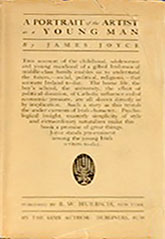A Portrait of the Artist as a Young Man
Critique • Quotes
 First edition
First editionFirst publication
1916
Literary form
Novel
Genres
Literary
Writing language
English
Author's country
Ireland
Length
Approx. 86,000 words
Mainly for Joycean scholars
I love the way this novel starts. If you're doing a biographical story, why not start at the very beginning with the perceptions of an infant?
Well, baby tuckoo grows up quickly in A Portrait of the Artist as a Young Man and becomes Stephen Dedalus, an obvious stand-in for Joyce himself. Dedalus suffers the oppression of the Catholic Church and the strictures of Irish culture as he grows into an intellectually gifted and rebellious young man. Especially vivid are the passages in which the adolescent Stephen fears his sexual urges are sinful and is terrified as he listens to a sermon detailing his future of eternal punishment in the fires of hell.
These bits are very deeply felt and somewhat claustrophobic. The intensely subjective point of view of the opening is maintained through the years, despite the use of third person, until the last few pages which are in diary form.
However this is not the full-blown stream-of-consciousness that Joyce develops in Ulysses. The narrative is sort of halfway between the naturalism of Dubliners and his later approach. Here he develops what is sometimes called free indirect style—writing in the third person but using the speech and thought styles of his subject.
The individual psyche
This has been highly influential in much modern writing, replacing the author's point of view. Think back to Dickens in which the narrative is usually delivered by someone not in the story, not even a being in himself, but with a godlike knowledge of everything going on, including in the heads of all the characters. For Joyce in Portrait of the Artist, the story is still told in third person but the narrative voice seems entirely Stephen Dedalus's—childish at first and growing through adolescence to young manhood along with him.
For writers in the twentieth century the decision as to what point of view to adopt largely replaces the question of first or third person. And often the perspective can jump around, head-spinningly in some works, which seems appropriate in an age when most of the vital popular art forms are visual: film, video and television.
But that's what makes Portrait of the Artist important to writers and academics. What makes it interesting to modern readers may be a result of this technique, which tends to involve readers more in an individual psyche, but is centred on Stephen's struggle against social, political and religious conventions. It's a very intellectual struggle going on in Stephen's mind, making for somewhat dry and fragmented storytelling.
Having had to study this novel in school and having also read it since then on my own, I don't think Portrait is particularly rewarding outside an academic environment. Only parts of it come to life. The rest is for scholars.
— Eric
Critique • Quotes

